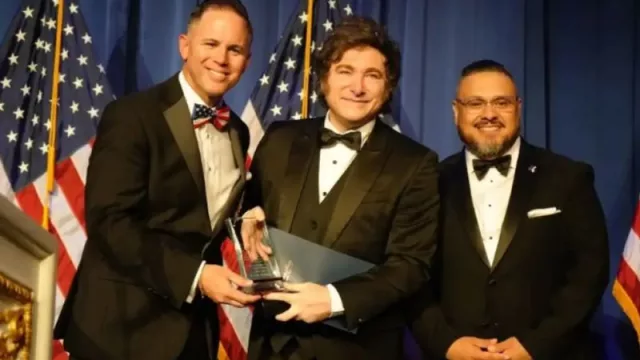Summary:
President Javier Milei announced at the American Patriots Gala that Argentina will realign its regulations to mitigate the impact of tariffs imposed by Donald Trump. This measure is the first step toward a free trade agreement between the two countries, with the intention of harmonizing tariffs for 50 Argentine products. This article analyzes the economic implications of this alliance, relevant data, and offers strategies for businesses and marketing in an environment of changing tariffs.
The strategic alliance between Javier Milei and Donald Trump to mitigate the impact of tariffs and promote free trade represents a significant opportunity for Argentina and the United States. By harmonizing tariffs and advancing toward a broader trade agreement, both countries can benefit from smoother and more equitable trade. For businesses and marketing, it is crucial to adapt to these changes, diversify markets, and capitalize on the opportunities that free trade offers. We encourage our readers to reflect on how they can apply these strategies in their own operations and to stay informed about trade developments.
Milei's Declaration at the American Patriots Gala
On April 2, 2025, at the American Patriots Gala, President Javier Milei was awarded the "Lion of Liberty Award" and took the opportunity to announce a significant measure: the realignment of Argentine regulations to comply with the tariff requirements proposed by Donald Trump. This decision aims to mitigate the impact of the 10% increase in tariffs on Argentine products exported to the United States. Milei highlighted that 9 out of the 16 necessary requirements have already been met and has instructed the Foreign Ministry and the Commerce Secretariat to advance on the remaining ones.
The Impact of Trump's Tariffs
Trump's announcement of imposing 10% tariffs on products from Argentina and other Latin American countries has generated concern in the Argentine export sector. This tariff is significantly higher than what various Argentine exports currently pay, putting the sustainability of those product sales at risk. However, Milei's strategy seeks not only to mitigate this impact but also to open the door to a broader trade agreement.
The Trade and Investment Framework Agreement (TIFA)
As part of this strategy, the Trump and Milei administrations are advancing the Trade and Investment Framework Agreement (TIFA). The initial goal is to harmonize tariffs for a basket of 50 products to facilitate their flow between the two countries, starting with 10 products. Milei has made it clear that this measure is just the first step toward a broader trade agreement, with the ultimate goal of a Free Trade Agreement (FTA) that eliminates trade barriers.
Relevant Economic Data
During 2024, Argentina experienced notable growth in its exports to North America, reaching a total of $6.395 billion, a 13.2% increase compared to the previous year. This increase allowed Argentina to record a trade surplus with the U.S. for the first time in 18 years, with a positive balance of $232 million. These gains are what Trump aims to correct with his tariffs, but Milei's strategy could reverse this situation.
Tariff Asymmetries
According to the U.S. Chamber of Commerce in Argentina (AmCham), there are significant tariff asymmetries between the two countries. For example, in food, Argentina levies a 16% import tariff, while the U.S. has a 4.6% tariff. In chemicals and industrial products, Argentina charges 8.1% tariffs, while the U.S. imposes a 0.3% tariff. In plastics, the local tariff is 11% compared to the U.S.'s 1.4%; in textiles, Argentina charges the highest rate, at 20.9%, while the U.S. applies a 6.1% tariff; and in metals, the local tariff is 13.7% while the U.S. charges 0.2%. Harmonizing these tariffs could significantly benefit both countries.
Strategies for Businesses and Marketing
In a context of changing tariffs, businesses must adapt quickly. Monitoring trade policies is crucial to anticipate changes and adjust strategies. Diversifying export markets can mitigate the risk of relying on a single market. Capitalizing on the opportunities that free trade offers, identifying products that can benefit from tariff harmonization, is essential. Collaborating with trade associations can provide information and support in adapting to new regulations. Finally, innovating in marketing strategies to highlight the benefits of products in a free trade context can attract new customers.
Frequently Asked Questions (FAQs):
-
What measures did Javier Milei announce to mitigate the impact of Trump's tariffs?
Milei announced the realignment of Argentine regulations to comply with the tariff requirements proposed by Trump, with the goal of mitigating the impact of the 10% increase in tariffs on Argentine products exported to the United States.
-
What is the Trade and Investment Framework Agreement (TIFA)?
The TIFA is a bilateral agreement between Argentina and the United States that aims to harmonize tariffs for a basket of 50 products to facilitate their flow between the two countries.
-
What are the tariff asymmetries between Argentina and the United States?
Argentina levies a 16% import tariff on food, while the U.S. has a 4.6% tariff. In chemicals and industrial products, Argentina charges 8.1% tariffs, while the U.S. imposes a 0.3% tariff. In plastics, the local tariff is 11% compared to the U.S.'s 1.4%; in textiles, Argentina charges the highest rate, at 20.9%, while the U.S. applies a 6.1% tariff; and in metals, the local tariff is 13.7% while the U.S. charges 0.2%.
-
How can businesses adapt to changing tariffs?
Businesses must monitor trade policies, diversify their export markets, capitalize on free trade opportunities, collaborate with trade associations, and adjust their marketing strategies.
-
What is the ultimate goal of Milei's strategy?
The ultimate goal is to advance toward a Free Trade Agreement (FTA) that eliminates trade barriers between Argentina and the United States.
-
Subscribe for free to receive all strategic information and be part of the largest business and culture community in the anglophone-Latino world!
Contact Infonegocios MIAMI:
Read Smart, Be Smarter!












Tu opinión enriquece este artículo: